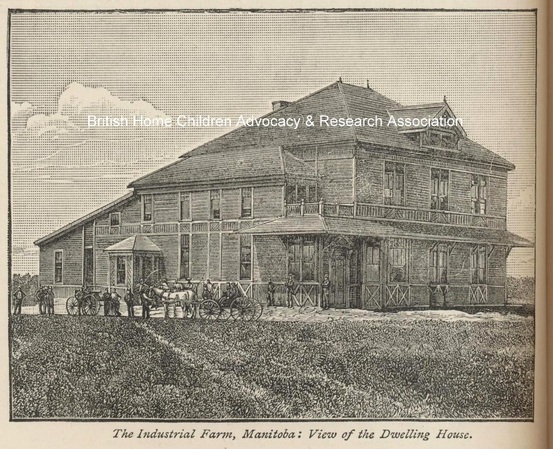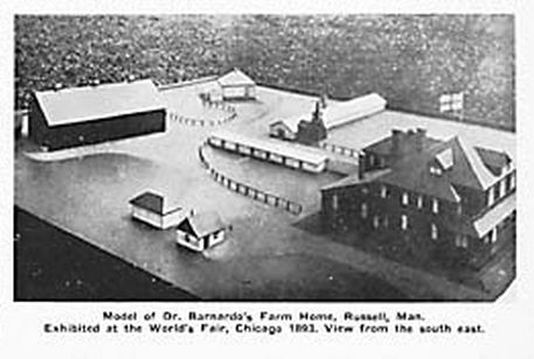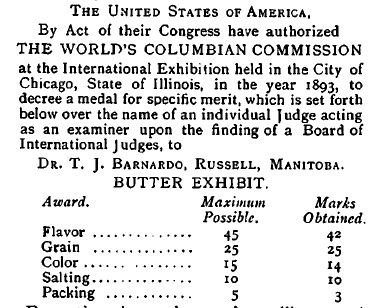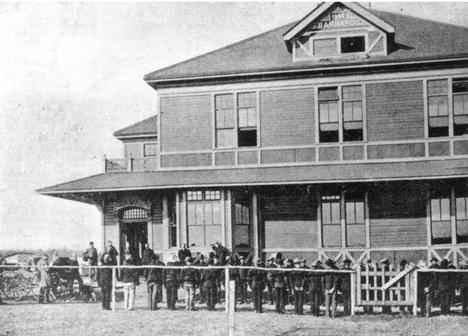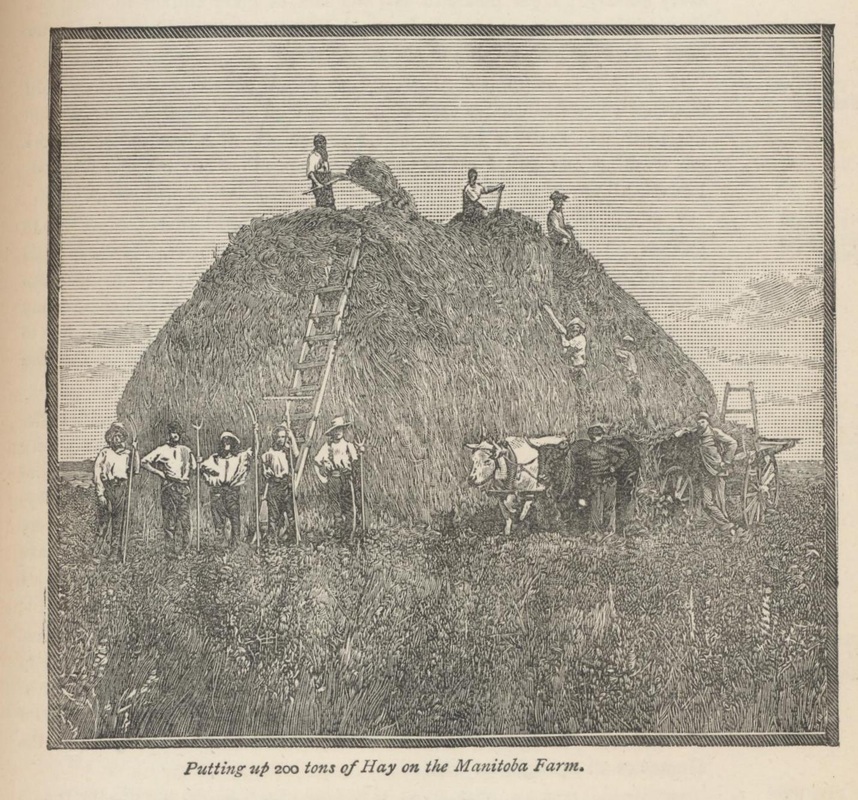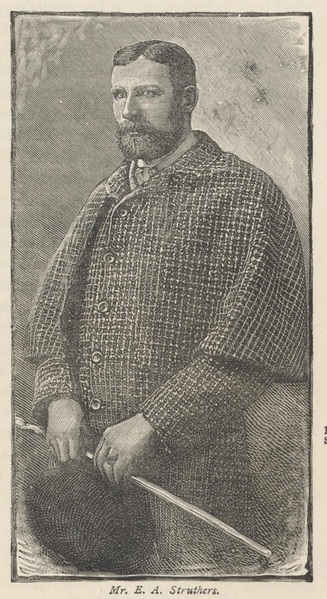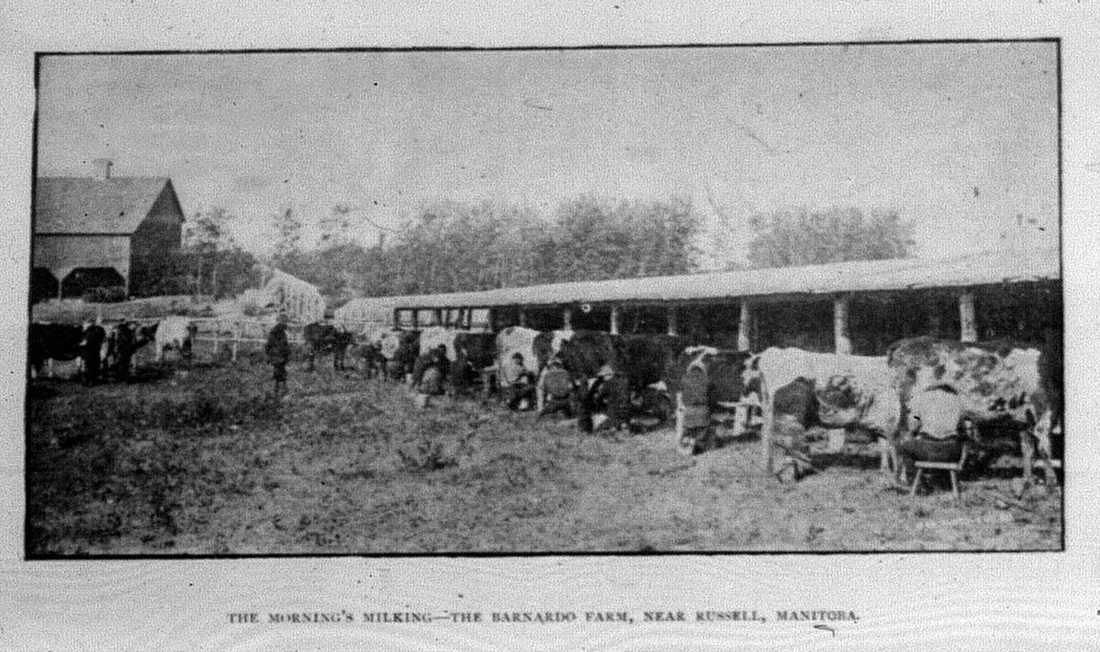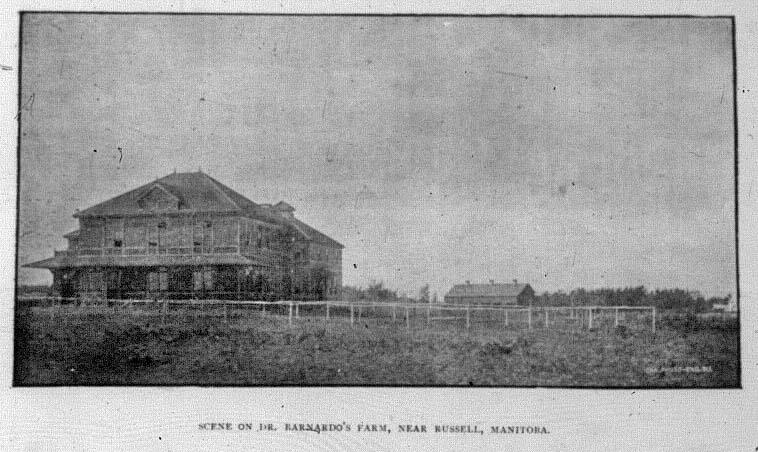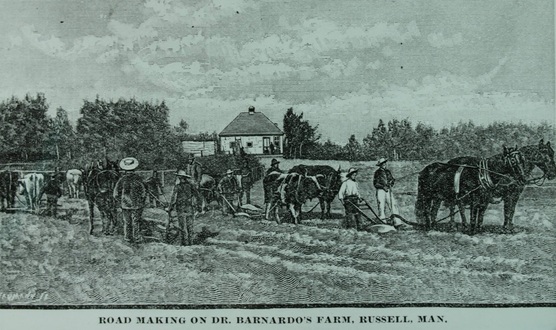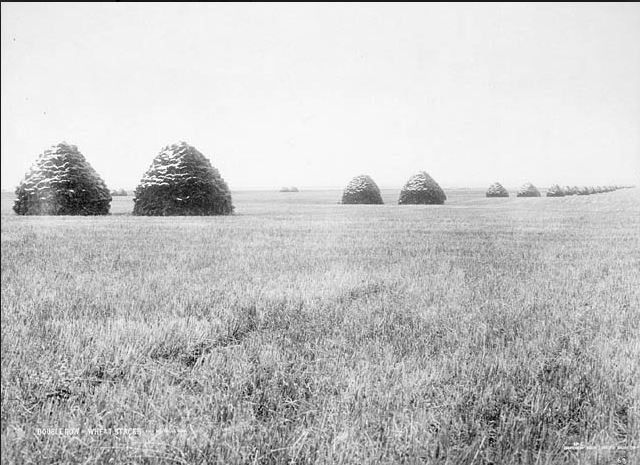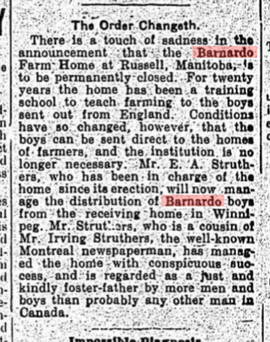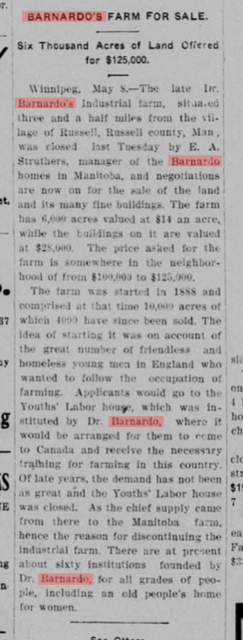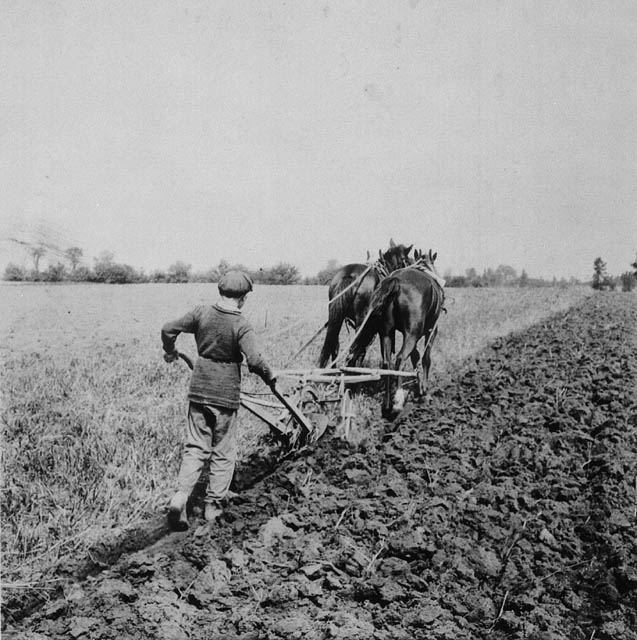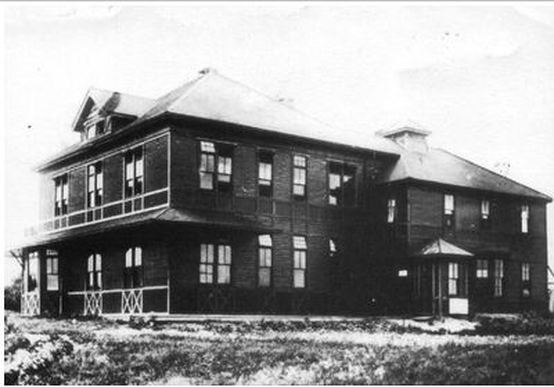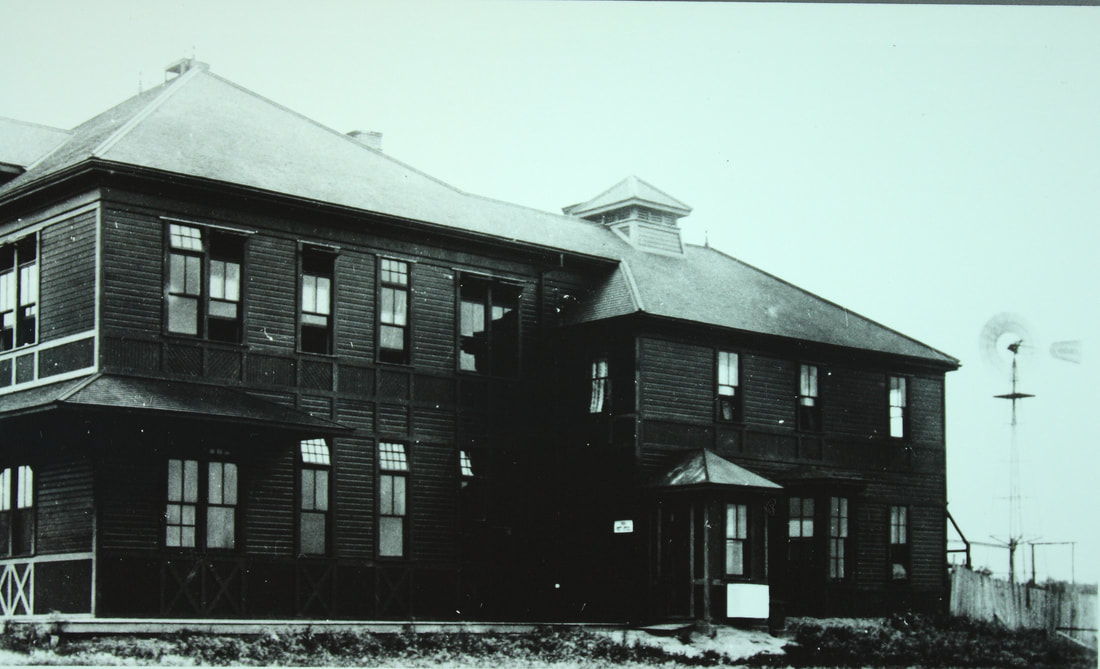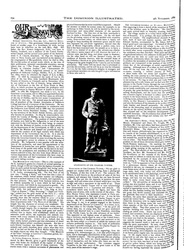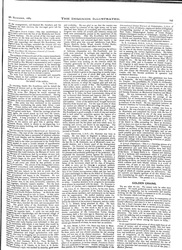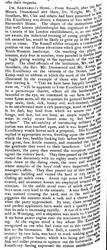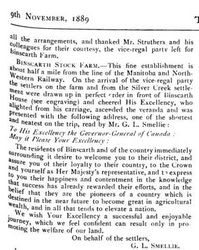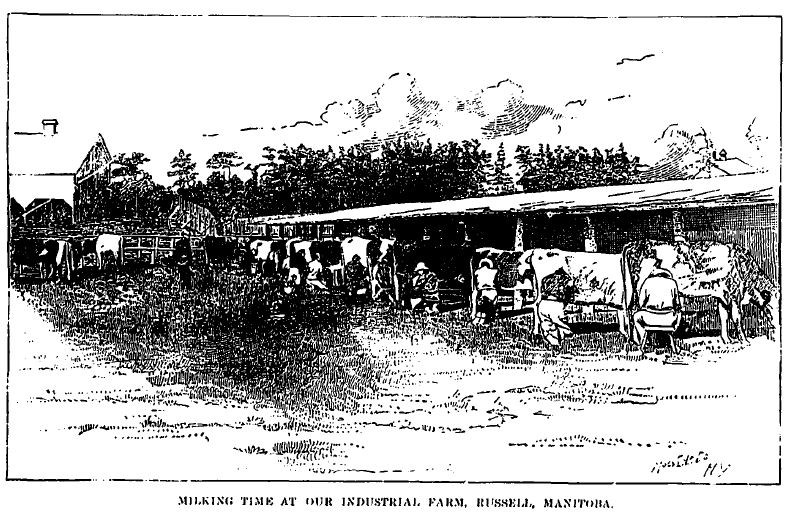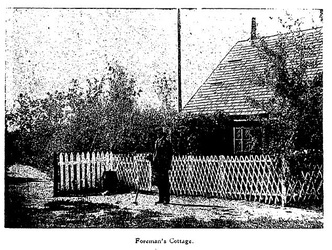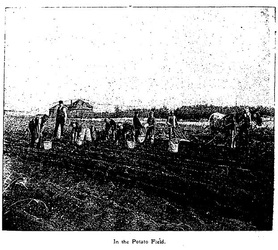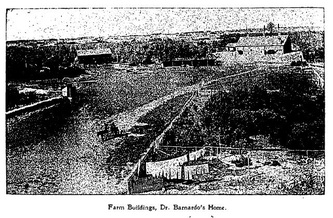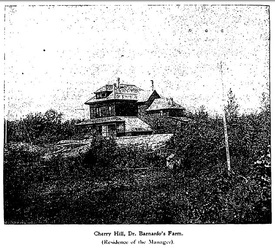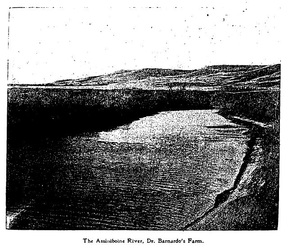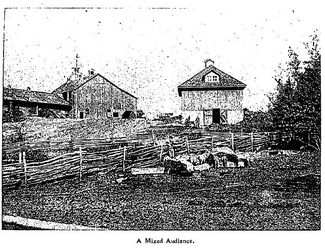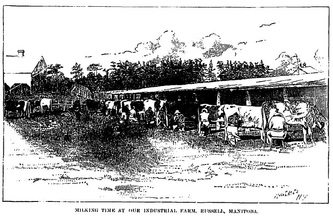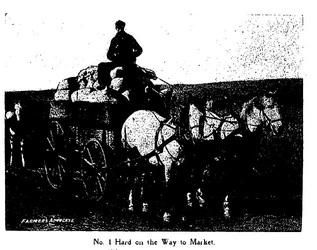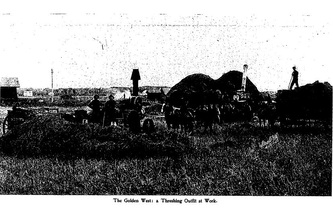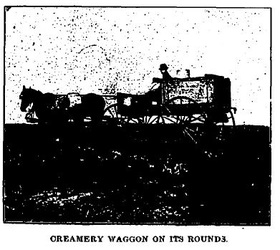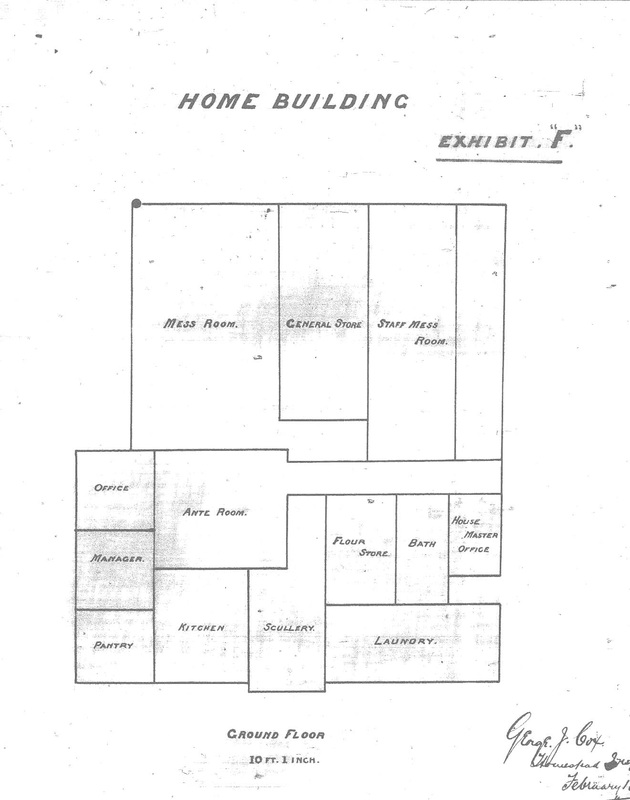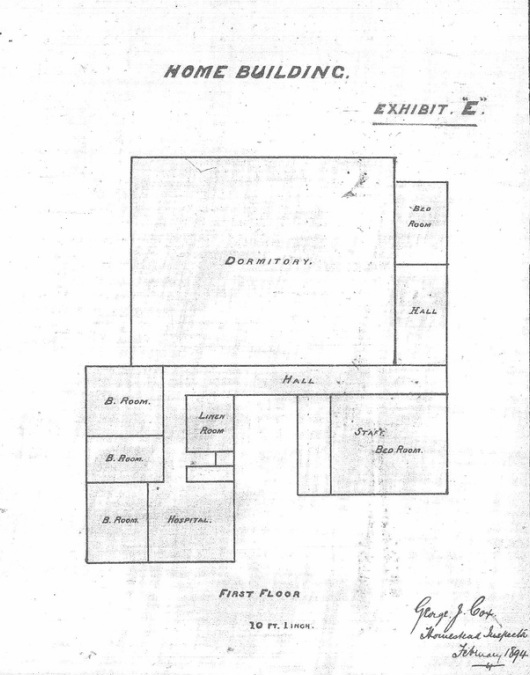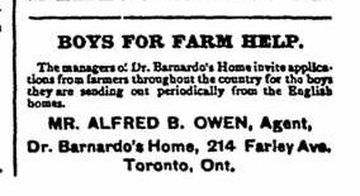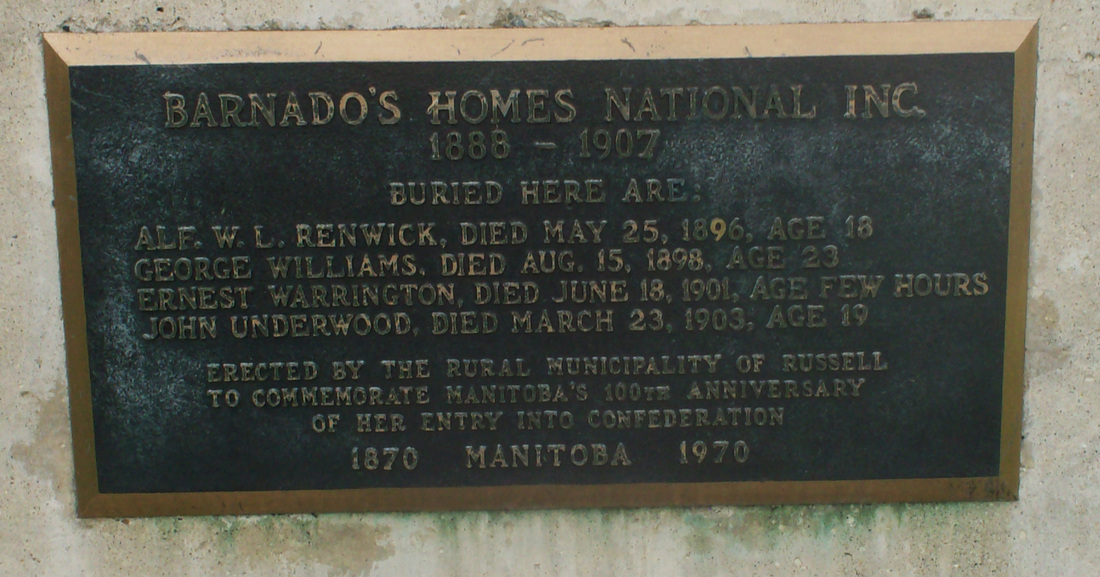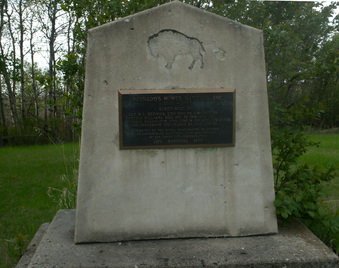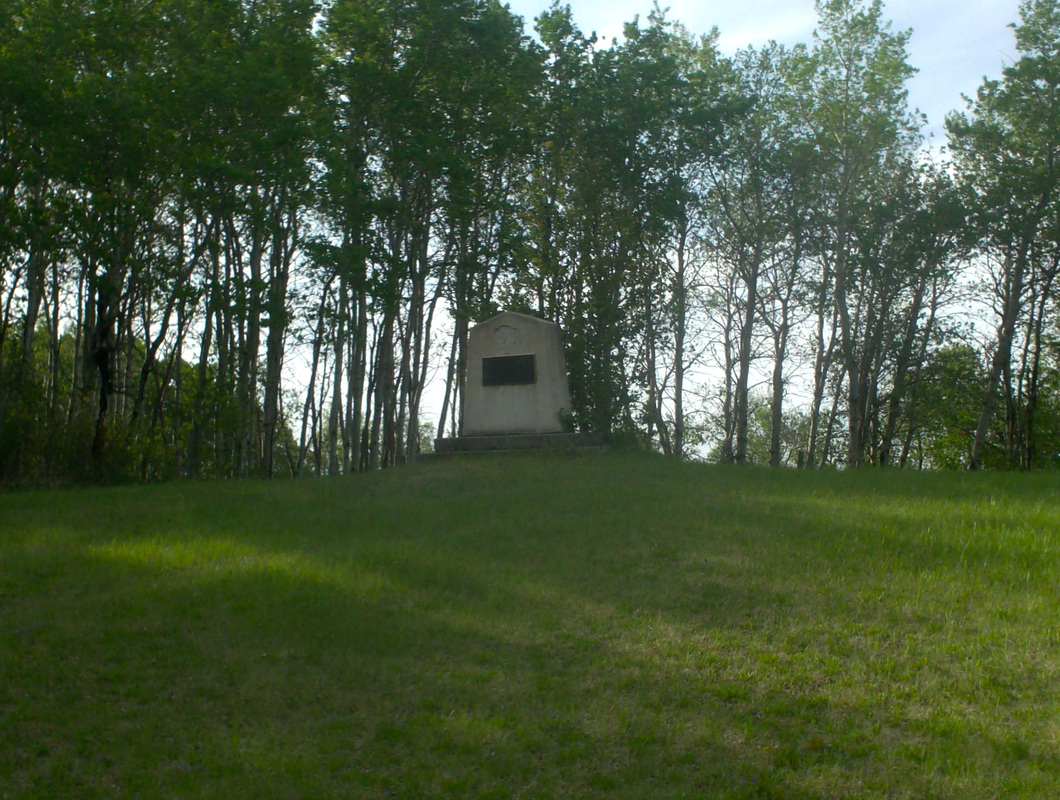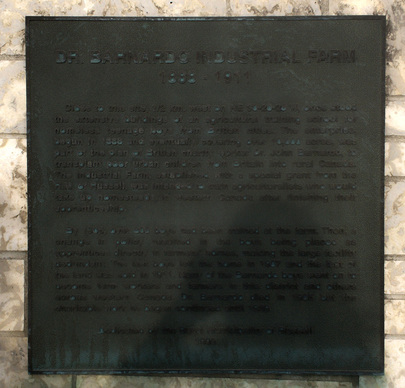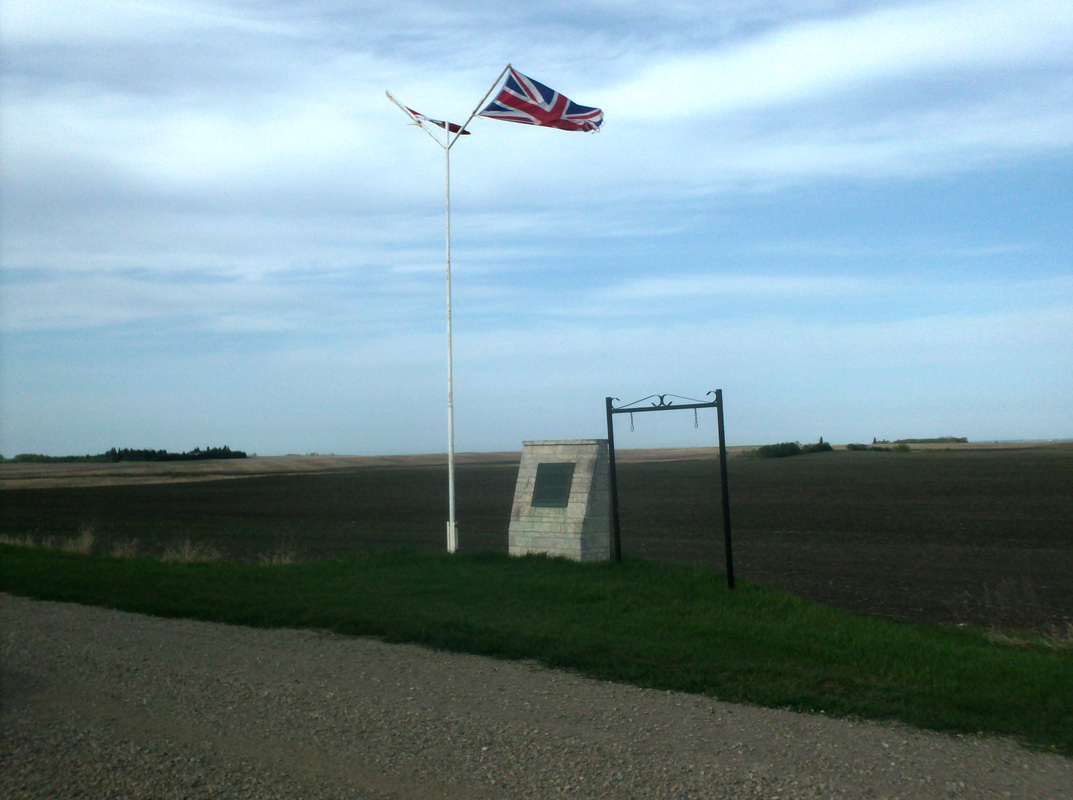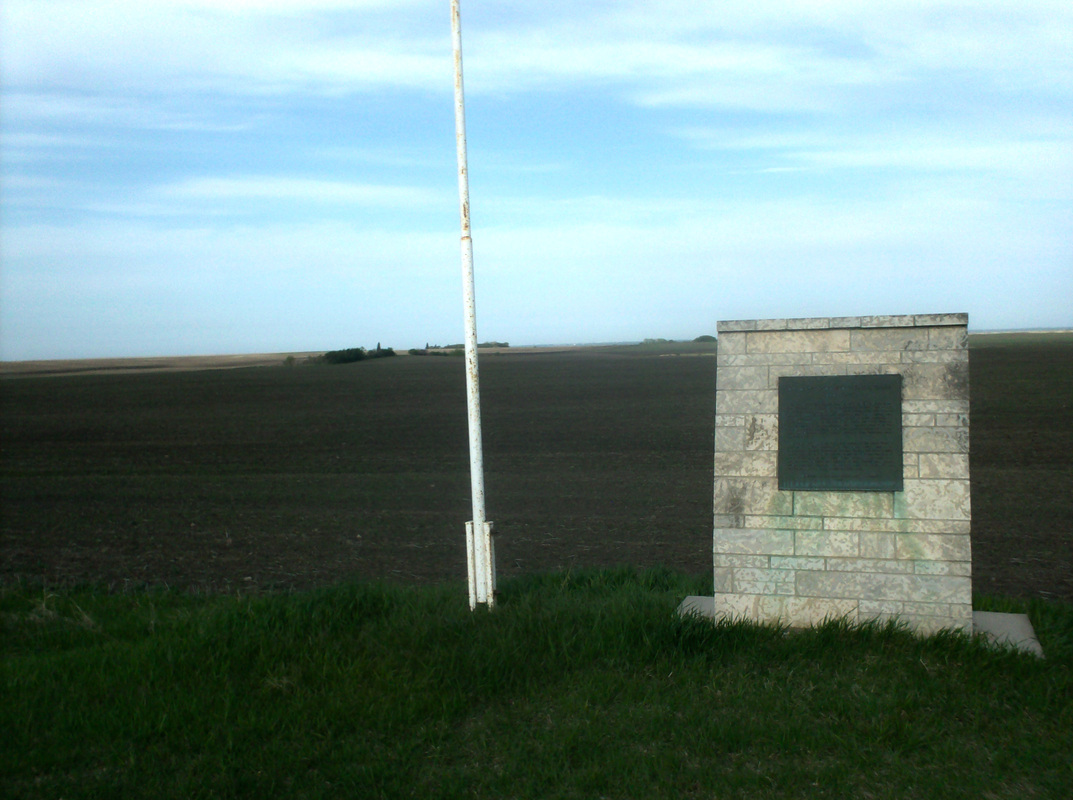Dr. Barnardo's Russell Manitoba Training Farm
Dr. Barnardo's Russell Manitoba Training Farm
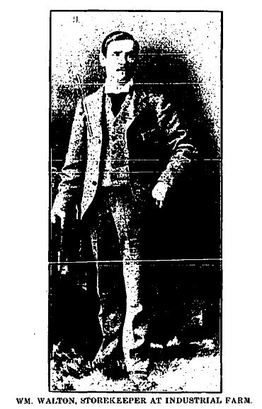
Dr. Barnardo's Russell Manitoba Training Farm was situated three and a half miles from the then boundaries of Russell, Manitoba and two hundred and twenty-two miles north west of Winnipeg. The Assiniboine River ran through the western portion of the property. The farm was run by Mr. E. A. Struthers. The first party of boys arrived on Sunday, April 15, 1888 with Mr. Struthers, a part of fifty boys from the Labour House in England. These boys had arrived in Canada just a week before, in Halifax aboard the Allan Line Steamer "Polynesian". The farm house had been newly built in 1887-88 and was capable of housing 100 boys with rooms for officers and offices, laundry, bathrooms, hospital, store and kitchen. Other building on the farm included a cottage for the manager, farm superintendent, a large barn, stable accommodating 45 cows, two stables for horses , a feeding shed and two piggeries which accommodated 300 hogs. Water was supplied to these buildings pumped by windmills.
A large garden of some 20 acres was cultivated on these grounds. Also on these grounds was a creamery. In the summer season wagons were sent through some 200 square miles collecting milk and cream from the farmers for manufacture into butter. A trained and certified butter-maker was kept in constant employ of the Farm. In 1893 Dr. Barnardo won a gold medal for creamery butter at the great Columbian exhibition.
The boys drafted for the Manitoba Farm were sent out from England under the agreement to work on the farm for one year for a wage, with the average term lasting about 8 months before the boys were placed out. They were awaken at 5am with a bugle, an hour and a half break mid day and worked till 6pm. A short prayer service was conducted twice during the day, by the house master in the am and by the manager before retiring in the evening. On Sunday a full service was resided over by a clergyman from Russell.
The home also maintained a library. Concerts and simple dramatic entertainment was often prepared by the lad to which the surrounding neighbors were invited.
A large garden of some 20 acres was cultivated on these grounds. Also on these grounds was a creamery. In the summer season wagons were sent through some 200 square miles collecting milk and cream from the farmers for manufacture into butter. A trained and certified butter-maker was kept in constant employ of the Farm. In 1893 Dr. Barnardo won a gold medal for creamery butter at the great Columbian exhibition.
The boys drafted for the Manitoba Farm were sent out from England under the agreement to work on the farm for one year for a wage, with the average term lasting about 8 months before the boys were placed out. They were awaken at 5am with a bugle, an hour and a half break mid day and worked till 6pm. A short prayer service was conducted twice during the day, by the house master in the am and by the manager before retiring in the evening. On Sunday a full service was resided over by a clergyman from Russell.
The home also maintained a library. Concerts and simple dramatic entertainment was often prepared by the lad to which the surrounding neighbors were invited.
In May 1889, Dr Barnardo wrote:
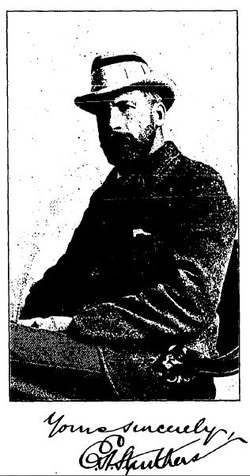
“A new departure in our emigration work of the most important character has taken place within the past two years in the acquisition of a large Industrial Farm near Russell, Manitoba. Negotiations for the acquisition of the Farm have been in progress for several years. I made preliminary inquiries during a visit to Canada in the autumn of 1884; much subsequent correspondence took place and finally the present site was pitched upon as being the most suitable in all respects for the purpose in view. In the autumn of 1887, I again visited the Dominion, and after carefully inspecting the location, plans were finally drawn up for the erection of the necessary buildings.
The area of the Farm now acquired is in all 8,960 acres or fourteen square miles. This has been acquired by grant and by purchase in several distinct sections. 1,000 acres were added during the year under review.
On the Farm, although there is no very large timber, there is wood enough to supply all our wants for years to come in the way of fuel, fences etc. A branch of the Assaineboine River runs through or bounds the property. It is within six miles of the main railway track, and I may eventually have to build a siding for the Home leading to the branch railway, thus making the conveyance of produce and general communication easy and profitable.
A commodious central building has already been erected at a cost of £3,500 which will accommodate over 100 lads. It is built of wood, and although I regret to say to grave neglect on the part of the Architects who had charge of its erection, it is anything but an ideal establishment, yet it has through the unceasing labours of the resident manager, been made a fairly comfortable structure. On the ground floor is a large dining hall, while dormitories occupy an equal space above. There is a large entrance hall, and from the windows of the hospital rooms on the second floor, is a view as charming as any that can be seen in the North West.”
In a report dated 1888, Dr E A Struthers, the Manager of the Farm, stated that the boys had weathered their first winter admirably and had “proved their pluck and suitability in a most encouraging degree”. It was hoped at that time to eventually maintain about 200 lads in constant residence. A beginning had already been made towards the establishment of a creamery and a cheese factory.
At that time it cost £9 to “fully equip, outfit and pay all expenses connected with the emigration of a boy or girl to any part of Ontario”. But “the peculiarities of the climate and the nature of the work” at the Farm some 2000 miles to the west, “require that considerable differences should be made in the outfit supplied” – in all, an additional expense of £2 per head but including “railway and ocean fares etc etc.”
The area of the Farm now acquired is in all 8,960 acres or fourteen square miles. This has been acquired by grant and by purchase in several distinct sections. 1,000 acres were added during the year under review.
On the Farm, although there is no very large timber, there is wood enough to supply all our wants for years to come in the way of fuel, fences etc. A branch of the Assaineboine River runs through or bounds the property. It is within six miles of the main railway track, and I may eventually have to build a siding for the Home leading to the branch railway, thus making the conveyance of produce and general communication easy and profitable.
A commodious central building has already been erected at a cost of £3,500 which will accommodate over 100 lads. It is built of wood, and although I regret to say to grave neglect on the part of the Architects who had charge of its erection, it is anything but an ideal establishment, yet it has through the unceasing labours of the resident manager, been made a fairly comfortable structure. On the ground floor is a large dining hall, while dormitories occupy an equal space above. There is a large entrance hall, and from the windows of the hospital rooms on the second floor, is a view as charming as any that can be seen in the North West.”
In a report dated 1888, Dr E A Struthers, the Manager of the Farm, stated that the boys had weathered their first winter admirably and had “proved their pluck and suitability in a most encouraging degree”. It was hoped at that time to eventually maintain about 200 lads in constant residence. A beginning had already been made towards the establishment of a creamery and a cheese factory.
At that time it cost £9 to “fully equip, outfit and pay all expenses connected with the emigration of a boy or girl to any part of Ontario”. But “the peculiarities of the climate and the nature of the work” at the Farm some 2000 miles to the west, “require that considerable differences should be made in the outfit supplied” – in all, an additional expense of £2 per head but including “railway and ocean fares etc etc.”
Road making on the Russell farm - 1892
Credit: Davidson Bros. / Library and Archives Canada / PA-117280
Double row wheat stacks, Dr. Barnardo's farm.
Double row wheat stacks, Dr. Barnardo's farm.
The Russell Manitoba farm house
| |||||||
The Dominion Illustrated magazine article about the
Russell Training Farm - November 9 1889
Milking time from the September 1895 Ups and Downs magazine
Photos of the Russell Manitoba Training Farm
published editions of "Ups and Downs"
please click thumb nail to see larger view
Floor Plans of the Russell Manitoba Training Farm farm house 1894
From the Manitoba Archives
Russell Manitoba Day Diary
January 25 1894 to January 31 1894
From the Manitoba Archives -
mentions: Joseph MCDermott, (arrived 1893-03-25), James Winder Bartley (arrived 1893-03-16), Aut Murdock (arrived 1893-03-16), J Shephard, H. H. Blackburn,
Possible Kirk's - Henry Kirk (arrived 1887-03-28)
Henry Kirk (arrived 1892-03-27), Henry Kirk (arrived 1887-03-28), James Isaac Kirk (arrived 1887-03-28),
Possible Kirk's - Henry Kirk (arrived 1887-03-28)
Henry Kirk (arrived 1892-03-27), Henry Kirk (arrived 1887-03-28), James Isaac Kirk (arrived 1887-03-28),
Your browser does not support viewing this document. Click here to download the document.
Frederick Fairweather 1892 work contract
document from the Manitoba Archives, migration information from the Library and Archives Canada Home Children shipping lists
Your browser does not support viewing this document. Click here to download the document.
Land Plan of the Russell, Manitoba estate
from the Manitoba Archives
Your browser does not support viewing this document. Click here to download the document.
1892 mention of Dr. Barnardo's Butter in the Sessional papers of the Dominion of Canada
An 1889 magazine ad
The farm no longer stands today, but there is a marker on the site where several of the children are buried. Also buried here is the Gardner's infant son.
BARNADO's HOMES NATIONAL INC. (spelled wrong)
1888-1907
Buried here are
Alf. W.L. Renwick, died May 25, 1896 age 18
George Williams, died Aug 15, 1898, age 23
Ernest Warrington, died June 18, 1901, age few Hours
John Underwood, died March 23, 1903, age 19
Erected by the rural Municipality of Russell
To Commemorate Manitoba's 100th anniversary
of her entry into confederation
1870 Manitoba 1970
Obit for John Underwood in the Ups and Downs April 1903
John UNDERWOOD, of the Manitoba Farm Home, went in December 1902 to the Winnipeg General Hospital, stayed 3 months, then returned to the Farm Home. There he died March 17, 1903. Buried in the cemetary at the Farm Home.
BARNADO's HOMES NATIONAL INC. (spelled wrong)
1888-1907
Buried here are
Alf. W.L. Renwick, died May 25, 1896 age 18
George Williams, died Aug 15, 1898, age 23
Ernest Warrington, died June 18, 1901, age few Hours
John Underwood, died March 23, 1903, age 19
Erected by the rural Municipality of Russell
To Commemorate Manitoba's 100th anniversary
of her entry into confederation
1870 Manitoba 1970
Obit for John Underwood in the Ups and Downs April 1903
John UNDERWOOD, of the Manitoba Farm Home, went in December 1902 to the Winnipeg General Hospital, stayed 3 months, then returned to the Farm Home. There he died March 17, 1903. Buried in the cemetary at the Farm Home.
Also is a marker which shows the former location of the Farm
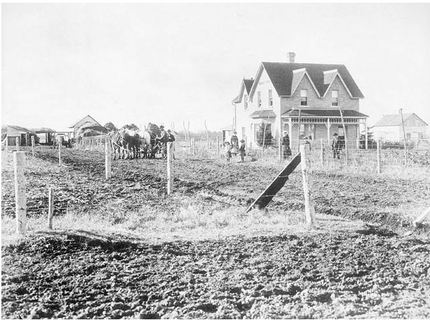
Credit: Davidson Bros. / Library and Archives Canada
The Barnardo Farm School, Russell, Manitoba
Provincial Archives of Manitoba http://www.gov.mb.ca/chc/archives/
200 Vaughan Street
Winnipeg, MN
R3C 1T5
Canada
(204)945-3971
The Archives has a book which was kept by the Superintendent of the Russell Farm. It does contain the names of some of the children that were sent to Manitoba.
source www.genealogic.co.uk
http://www.ourroots.ca/page.aspx?id=967984&qryID=3e4565ff-24ab-4610-b3c2-9cd8ebf2235b&pageSizeToggle=small
http://www.ourroots.ca/e/toc.aspx?id=4559
http://postalhistorycorner.blogspot.co.uk/2011/09/child-migration-to-canada-british-home.html
http://www.mhs.mb.ca/docs/sites/barnardofarm.shtml
200 Vaughan Street
Winnipeg, MN
R3C 1T5
Canada
(204)945-3971
The Archives has a book which was kept by the Superintendent of the Russell Farm. It does contain the names of some of the children that were sent to Manitoba.
source www.genealogic.co.uk
http://www.ourroots.ca/page.aspx?id=967984&qryID=3e4565ff-24ab-4610-b3c2-9cd8ebf2235b&pageSizeToggle=small
http://www.ourroots.ca/e/toc.aspx?id=4559
http://postalhistorycorner.blogspot.co.uk/2011/09/child-migration-to-canada-british-home.html
http://www.mhs.mb.ca/docs/sites/barnardofarm.shtml
